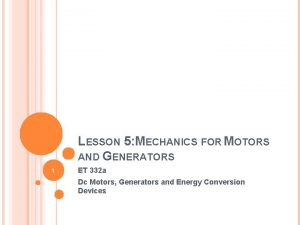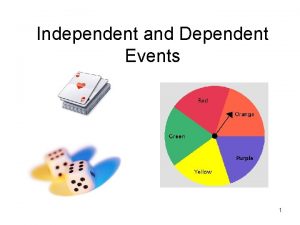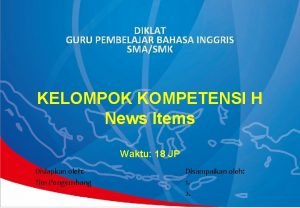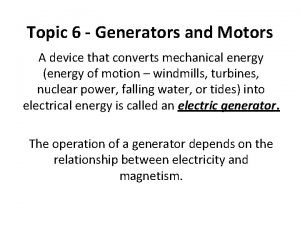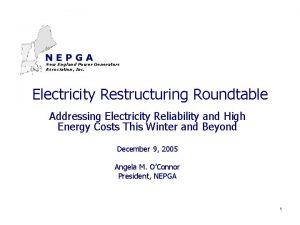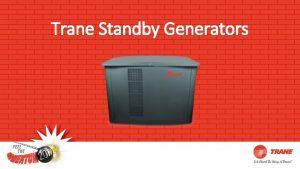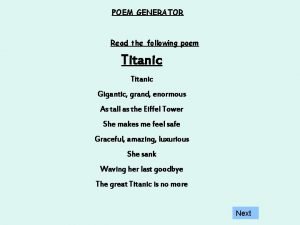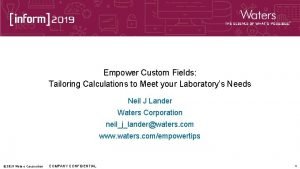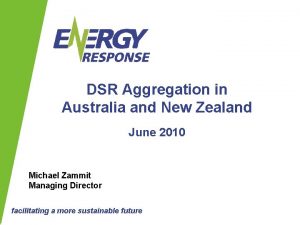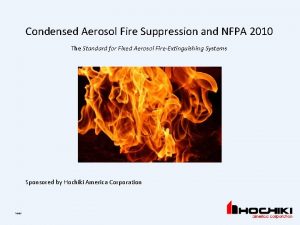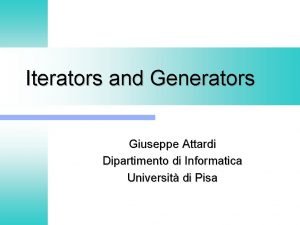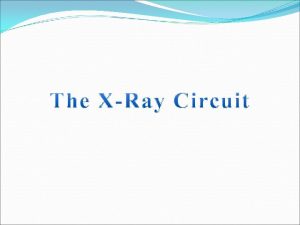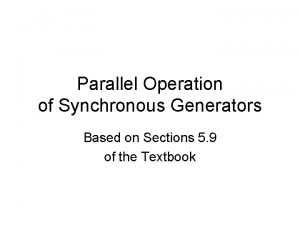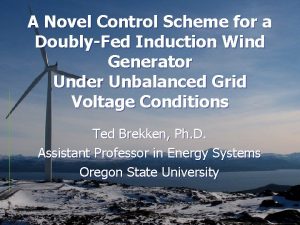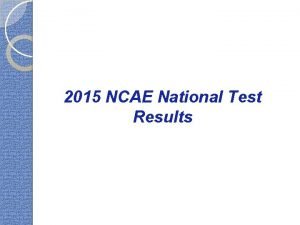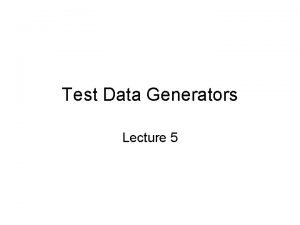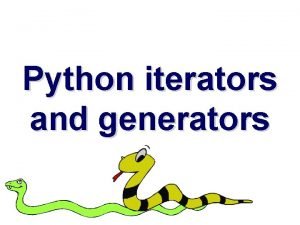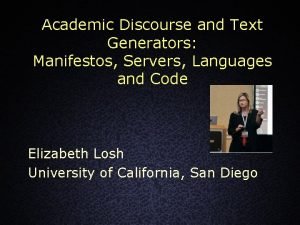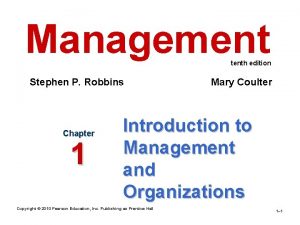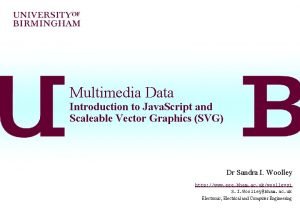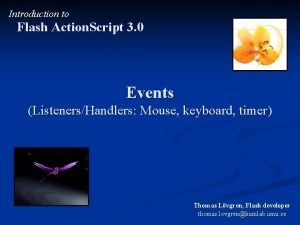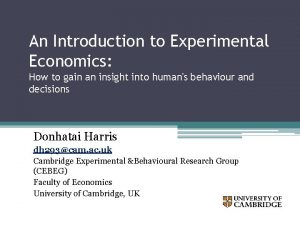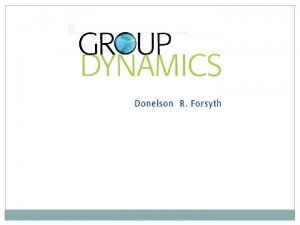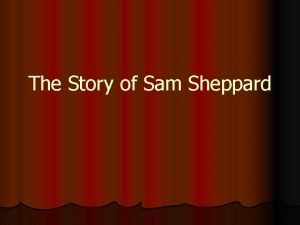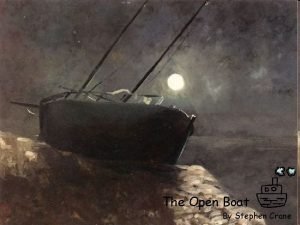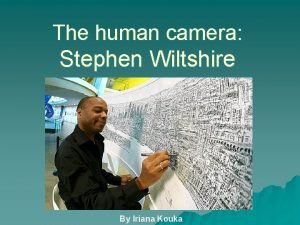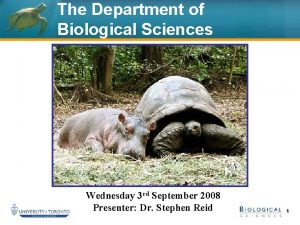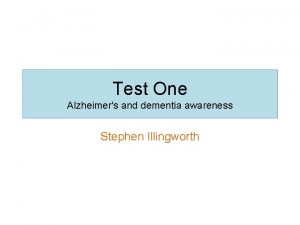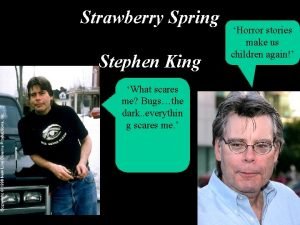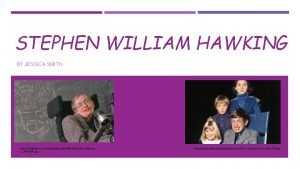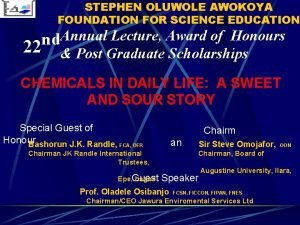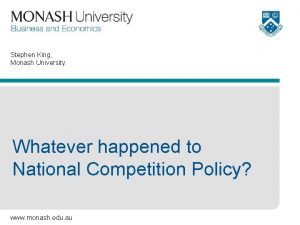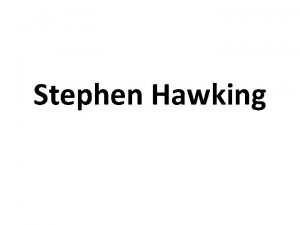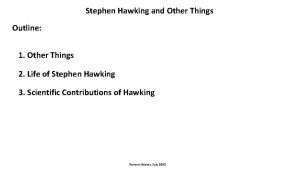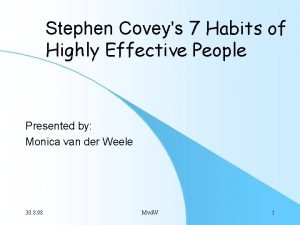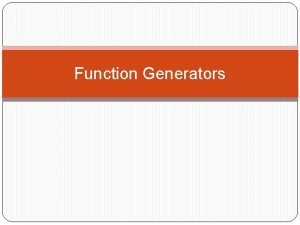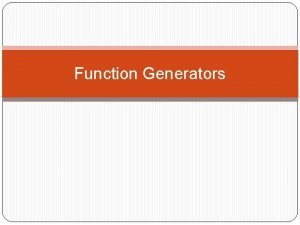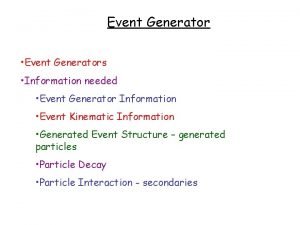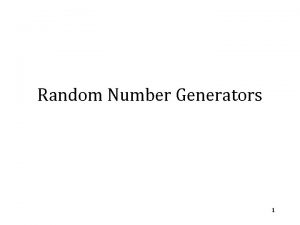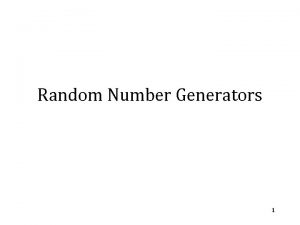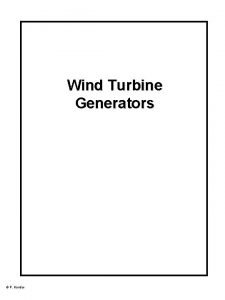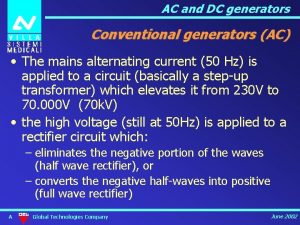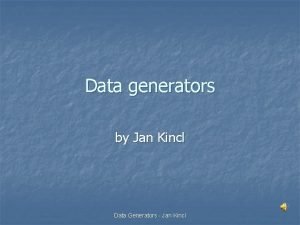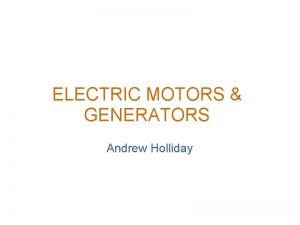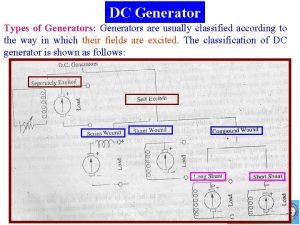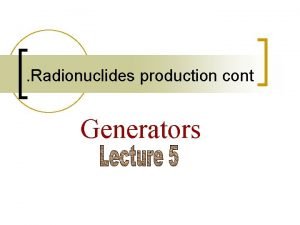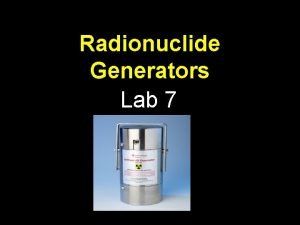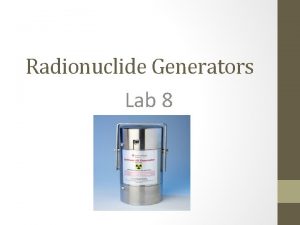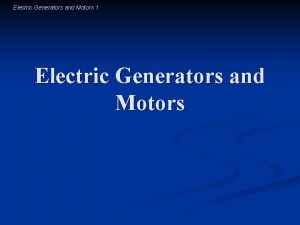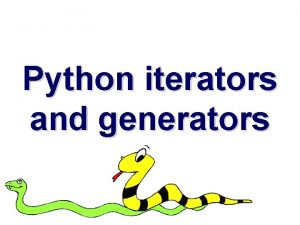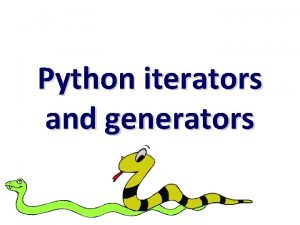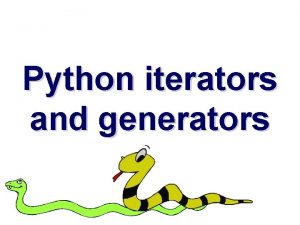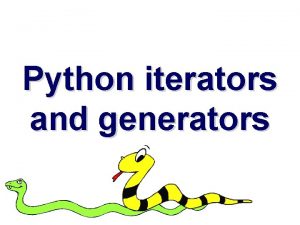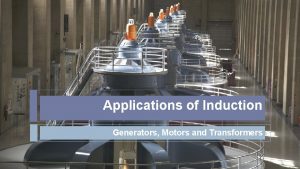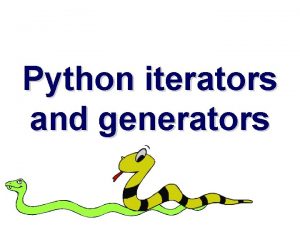Introduction to Event Generators Stephen Mrenna CDSimulations Group
































































- Slides: 64

Introduction to Event Generators Stephen Mrenna CD/Simulations Group Fermilab Email: mrenna@fnal. gov CTEQ SS 2002 Stephen MRENNA Fermilab 1

Motivation § Experiments rely on Monte Carlo programs which calculate physical observables § § § § Correct for finite detector acceptance Find efficiency of isolation cuts Jet Energy (out of cone) corrections Connect particles to partons Determine promising signatures of “new” physics Optimize cuts for discovery/limit Planning of future facilities. . . CTEQ SS 2002 Stephen MRENNA Fermilab 2

Field Theory Trinity § Many different calculational schemes from same basic principles § Tree level (lowest order) § Many partons § All spin correlations § Full color structure § NNLO How to make sense of it all? How to use the best parts of each? § Smaller theoretical errors § More inclusive kinematics § “All” orders in towers of logarithms § Leading Logarithm, NLL, … § Analytic resummation (soft gluons integrated out) § Parton showers (soft gluons at leading log) CTEQ SS 2002 Stephen MRENNA Fermilab 3

§ Many computer programs § Comp. HEP / Madgraph / Whizard / … § MCFM / DYRad / Jet. Rad / … § Pythia / Herwig / Isajet / Ariadne / … § Often treated as Black Boxes § Purpose of the Lectures: Open the Box § § Separate the regions of validity Determine overlap Merge (use the best of each) Special role of Event Generators CTEQ SS 2002 Stephen MRENNA Fermilab 4

An Important Topic! § Uncertainties in how events should be generated are significant or most important errors for: § Top mass determination § Precision W-mass extraction § Together, a window to new physics § NNLO jet predictions with k. T-algorithm § … § Our ignorance limits what we can learn about Nature CTEQ SS 2002 Stephen MRENNA Fermilab 5

Event Generators: Introduction § Most theorists make predictions about Partons § Valid to a specific order in perturbation theory § The asymptotic states are not the physical ones § Quarks & gluons confined within hadrons § Some predictions have peculiar properties § Slicing of phase space with cutoffs § Negative weights cancelling positive ones § Experimentalists measure Objects in detector § No distinction between Perturbative and Non. Perturbative physics § In- and Out-states are quasi-stable particles § Multiplicities can be large § Observe (positive) integer number of events CTEQ SS 2002 Stephen MRENNA Fermilab 6

Event Generators Connect “Theory” to “Experiment” § Describe the complicated Experimental Observable in terms of a chain of simpler, sequential processes § Some components are perturbative § hard scattering, parton showering, some decays, … § Others are non-perturbative and require modelling § hadronization, underlying event, k. T smearing, … § models are not just arbitrary parametrizations, but have semiclassical, physical pictures § Sometimes as important as the perturbative pieces § The Chain contains complicated integrals over probability distributions § Positive Definite § Rely heavily on Monte Carlo techniques to choose a history § Final Output is E, p, x, t of stable and quasi-stable particles § Ready to Interface with Detector Simulations CTEQ SS 2002 Stephen MRENNA Fermilab 7

Interconnection Bose-Einstein Partial Event Diagram Particle Decay Remnant Hadronization “Underlying Event” ISR CTEQ SS 2002 Hard Scatter Stephen MRENNA Fermilab FSR Resonance Decay 8

Hard Scattering § Characterizes the rest of the event § Sets a high energy scale Q § Fixes a short time scale where partons are free objects § Allows use of perturbation theory § External partons can be treated as on the mass-shell § Valid to 1/Q § Properties at scales below Q are swept into PDFs and fragmentation functions § This is the Factorization Theorem § Sets flow of Quantum numbers (particularly Color) § Note: Parton shower and hadronization models work in 1/NC approximation § Gluon replaced by color-anticolor lines § All color flows can be drawn on a piece of paper CTEQ SS 2002 Stephen MRENNA Fermilab 9

Examples of color flows Can influence: 1. Pattern of additional soft gluon radiation 2. CTEQ SS 2002 Fragmentation/Hadronization Stephen MRENNA Fermilab 10

Tree Level Calculation of Hard Scatter § Read Feynman rules from i. Lint § Use Wave Functions from Relativistic QM § Propagators (Green functions) for internal lines § Specify initial and final states § Track spins/colors/etc. if desired § Draw all valid graphs connecting them § Tedious, but straight-forward § Algorithm can be coded in a computer program § Mad. Graph / Comp. HEP / … § Calculate (Matrix Element)2 Number of graphs grows quickly with number of partons § Evaluate Amplitudes, Add them, and Square (Mad. Graph) § Symbolically Square, Evaluate (Comp. HEP) § Do something trickier (Alpha) Efficiency decreases with § (Monte Carlo) Integrate over Phase Space number of § VEGAS … internal lines CTEQ SS 2002 Stephen MRENNA Fermilab 11

Comp. HEP Diagrams for ud W+bb Vcb Vub Vtd Vcd CTEQ SS 2002 Naïve application of rules leads to many diagrams! Stephen MRENNA Fermilab 12

Higher Order = Higher Topology How sensitive is Mbb to additional gluon radiation? Both diagrams have 6 colored lines CTEQ SS 2002 Stephen MRENNA Fermilab Amplitudes diverge in soft/collinear limit 13

Tree Level Overview § § Leading order matrix element calculations describe explicit, manyparticle topologies § Well-separated partons § Full spin correlations § Color flow § § Many computer programs § § Different approaches to the same problem § Analytic vs Numeric § Matrix Element vs Phase Space CTEQ SS 2002 § Comp. Hep § SM + MSSM + editable models § Symbolic evaluation of squared matrix element § 2 4 -6 processes with all QCD and EW contributions § color flow information § outputs cross sections/plots/etc. Grace § similar to Comp. Hep Madgraph § SM + MSSM § helicity amplitudes § “unlimited” external particles (12? ) § color flow information § not much user interface (yet) Alpha + O’Mega § does not use Feynman diagrams § gg 10 g (5, 348, 843, 500 diagrams) Stephen MRENNA Fermilab 14

Why Go Beyond Tree Level ? § Tree level (lowest order) prediction X has a large dependence on the scale in couplings § “the” hard scale is ambiguous § Ideally d. X/d =0, but not possible if X ~ g( )N § More likely if X= a g( )N + b g( )N+1 § No clear way to merge different topologies § Some W/Z+N parton events will be reconstructed as W/Z + N-1 jet events § Some W/Z+N-1 parton events will be W+N-1 jet events § No way to avoid soft and/or collinear singularities § In fact, multiple gluon emission occurs in these kinematic configurations § No direct connection to hadronization CTEQ SS 2002 Stephen MRENNA Fermilab 15

NLO: Looking Beyond the Trees Example: hb+X gs gs 2 gs 3 CTEQ SS 2002 Stephen MRENNA Fermilab 16

NLO: Some Improvement § Scale dependence greatly reduced § Shape of some distributions similar up to scale (K) factor § But kinematics are inclusive § Separation of different topologies depends on cutoff § Multiple, soft-collinear gluon emissions are not included CTEQ SS 2002 Stephen MRENNA Fermilab 17

Wbb and Zbb CTEQ SS 2002 Stephen MRENNA Fermilab 18

W+jj also to NLO § W+jj can still be used to normalize W+bb § Overall scale dependence of W/Z+jj reduced § Program MCFM (Campbell, R. K. Ellis) CTEQ SS 2002 Stephen MRENNA Fermilab 19

The need for even higher order… § As long as observables are inclusive enough, this is extremely important and useful § Beware of correlations between kinematics of different objects § These can be sensitive to multiple, soft gluon emission CTEQ SS 2002 Stephen MRENNA Fermilab 20

Resummation: Beyond Fixed Order § Consider W production § At LO in p. QCD, the rapidity Y and transverse momentum QT of the W are fixed by incoming partons § At NLO, single gluon emission occurs with QT>0 § Cross sections at large QT or QT averaged are described well by fixed order in S § However, some observables are sensitive to region QT « Q § For W/Z production, this is most of the data! § Solution: Reorganize perturbative expansion § N ln. M(Q 2/QT 2) § Sums up infinite series of soft gluon emissions § k. T dependent PDF’s CTEQ SS 2002 Stephen MRENNA Fermilab 21

Sudakov Effect § Solid: resummed § Superior at lower QT § Dot/Dash-dot: W+1 j/W+2 j Multiple soft and collinear gluon emissions included, but integrated out § Superior at high QT § Ln(Q/Q)=0 CTEQ SS 2002 Stephen MRENNA Fermilab 22

Higher Order vs All Order § In the lower QT region, significantly different predictions from NLO § Decay products retain information about W production § Important for MW measurement in Run II NLO prediction depends on cutoff CTEQ SS 2002 Stephen MRENNA Fermilab 23

Review of “Hard Scattering” § Tree Level Predictions § Cons § Also requires large PT’s and angular separations § Pros § Full spin and color correlations § “Easy” to calculate § Good for large PT’s and angular separations § Cons § Rate not reliable § Not clear how to merge different topologies § (N)NLO Predictions § Pros § Reduced scale dependence § Merging of topologies CTEQ SS 2002 § Resummation § Pros § (N)NLO accuracy with all orders accuracy in kinematics § Cons § No information on soft gluons § All of these approaches ignore details of physics below hard scale § Not yet connected to hadronization Stephen MRENNA Fermilab § Color must be screened 24

Monte Carlo Event Generator § Calculate the probability of a hard scattering at scale Q treating in and out partons as on-shell § Rest of the event can be described by positive probability distributions § Prior to and after hard scatter, evolution of partons is sensitive to quantum fluctuations below scale Q § § § Cancellation of Virtual (-) and Real (+) effects occurs at scales too small to resolve § For color evolution, scale is typically QCD In-partons evolved from some parents with P=1 Out-partons evolve into daughters with P=1 Final state partons hadronize with P=1 Beam particle remnant also hadronizes with P=1 § The Factorization Theorem is essential for this to work CTEQ SS 2002 Stephen MRENNA Fermilab 25

“Monte Carlo” “Event Generator” § Improving the Physics complicates the Numerics § Difficult Integrand in Many dimensions § Well-suited to Monte Carlo methods § Integrands are positive definite § Normalize to be probability distributions § Hit-or-Miss § § Test integrand to find maximum weight WMAX (or just guess) Calculate weight W at some random point If W > r WMAX, then keep it, otherwise pick new W Sample enough points to keep error small § Can generate events like they will appear in an experiment § N = [Xb] L[Xb-1] § NNLO QCD programs are not event generators § Not positive definite (Cancellations between N and N+1) § Superior method for calculating suitable observables § Tree level programs are not event generators § Only limited topologies § Can follow spins/color exactly CTEQ SS 2002 Stephen MRENNA Fermilab 26

Parton Shower § Hard Scattering sets scale Q § Structure f(x, Q 2) or fragmentation D(x, Q 2) functions, couplings S(Q 2), etc. are evaluated at Q § Asymptotic states have a scale Q 0~1 Ge. V § Incoming/Outgoing partons are highly virtual § How do incoming partons acquire mass 2 ~ -Q 2 ? § INITIAL STATE RADIATION (ISR) § How do outgoing partons approach the mass shell ? § FINAL STATE RADIATION (FSR) § Typically, resolving smaller scales generates many partons with lower virtuality § Virtualities on the order of QCD are expected for partons bound in hadrons § “traditional” calculations based on a small number of Feynman diagrams are incomplete § Parton Showering Monte Carlos are an approximation to high -order, perturbative QCD CTEQ SS 2002 Stephen MRENNA Fermilab 27

Parton Showering: More Motivation Semi-classical description § Accelerated charges radiate § Color is a charge, and thus quarks also radiate § Gluon itself has charge (=q-q* pair to 1/Nc) Field Theory § Block and Nordsieck (QED) § Must include virtual and real (emission) corrections to obtain IR finite cross section § Electron is ALWAYS accompanied by cloud of quanta (photons) CTEQ SS 2002 Stephen MRENNA Fermilab 28

Example: gluon emission in * events Q 2 t t 0 when gluon is Soft, collinear or both u s z 1 when gluon is Soft, collinear or both § § Factorization of Mass Singularities Probability of one additional soft emission proportional to rate without emission § d N+1 = N S/2 dt/t dz P(z) CTEQ SS 2002 Stephen MRENNA Fermilab 29

Tower of emissions described by Sudakov Form Factor § Series of subsequent showers “exponentiate” § Shower of resolvable emissions q*(p) q(zp) + g([1 -z]p) § Emission RESOLVED if z. C < z < 1 - z. C § Sudakov built from Probability of no resolvable emission for small t § Prob(tmax, t) = S(tmax)/S(t) = random r § § Pick random r and solve for new t Resolvable emission at the end of “nothing”: d. S/dt Continue picking new t’s down to tmin ~ QCD Stop shower & begin hadronization CTEQ SS 2002 Stephen MRENNA Fermilab 30

Virtuality-Ordered PS Highly virtual CTEQ SS 2002 Nearly on-shell Stephen MRENNA Fermilab 31

Initial State Radiation § Similar picture, but solving DGLAP for PDFs Increasing parton virtuality Parent has more momentum CTEQ SS 2002 Stephen MRENNA Fermilab 32

Sjostrand Backwards Showering Marchesini/Webber § -Q 02>-Q 12>…>-Qn 2 § showering added after hard scatter with unit probability § Something happens, even if not resolvable CTEQ SS 2002 Stephen MRENNA Fermilab PRIMORDIAL KT 33

Parton Shower is a Resummation § Analytic Resummation § soft gluon emissions exponeniate into Sudakov form factor § k. T conserved § Total rate at (N)NLO § Parton Showering § DGLAP evolution generates a shower of partons § LL with some N-LL § Exact gluon kinematics § LO event rates § modified PDF's § underestimates single, hard § corrections for hard emissions § soft gluons are integrated out § Explicit history of PS § Predicts observables for a theoretical W § Needs modelling of nonperturbative physics § More closely related to object identified with a W § natural transition to hadronization models § Follow color flow down to small scales Similar physics, but different approach with different regimes of applicability CTEQ SS 2002 Stephen MRENNA Fermilab 34

Comparison of Predictions Analytic Resum Example of Treating Kinematics differently in shower Example of Matrix Element Corrections to Parton Showering CTEQ SS 2002 Stephen MRENNA Fermilab 35

Color Coherence § In previous discussion of PS, interference effects were ignored, but they can be relevant § Add a soft gluon to a shower of N almost collinear gluons § incoherent emission: couple to all gluons § |M(N+1)|2 ~ N S NC § coherent emission: soft means long wavelength § resolves only overall color charge (that of initial gluon) § |M(N+1)|2 ~ 1 S NC CTEQ SS 2002 Stephen MRENNA Fermilab 36

Angular-Ordered PS § Showers should be Angular-Ordered § = p. I • p. J / EI EJ = (1 - cos IJ) ~ IJ 2/2 § 1 > 2 > 3 … § Running coupling depends on k. T 2 z(1 -z)Q 2 § Dead Cone for Emissions § § Q 2 = E 2 < Q 2 max = z 2 E 2 < 1 [not 2] < /2 § No emission in backwards hemisphere CTEQ SS 2002 Stephen MRENNA Fermilab 37

Color Coherence in Practice § Emission is restricted inside cones defined by the color flow Partonic picture Large N picture Enhanced emission Beam line CTEQ SS 2002 Stephen MRENNA Fermilab 38

Essential to Describe Data § 3 Jet Distributions in Hadronic Collisions Full Coherence No Coherence Soft emissions know about beam line (large Y) Partial Coherence Pseudorapidity of Gluon Jet CTEQ SS 2002 Stephen MRENNA Fermilab 39

The Programs (Pyt/Isa/Wig/Aria) § ISAJET § Q 2 ordering with no coherence § large range of hard processes § PYTHIA § Q 2 ordering with veto of non-ordered emissions § large range of hard processes § HERWIG § complete color coherence & NLO evolution for large x § smaller range of hard processes § ARIADNE § complete color dipole model (best fit to HERA data) § interfaced to PYTHIA/LEPTO for hard processes CTEQ SS 2002 Stephen MRENNA Fermilab 40

Parton Shower Summary § Accelerated color charges radiate gluons § Gluons are also charged § Showers of partons develop § IMPORTANT effect for experiments § Showering is a Markov process and is added to the hard scattering with P=1 § Derived from factorization theorems of full gauge theory § Performed to LL and some sub-LL accuracy with exact kinematics § Color coherence leads to angular ordering § Modern PS models are very sophisticated implementations of perturbative QCD § Still need hadronization models to connect with data § Shower evolves virtualities of partons to a low enough values where this connection is possible CTEQ SS 2002 Stephen MRENNA Fermilab 41

§ Strings (Pythia) Comparison § PRODUCTION of HADRONS is nonperturbative, collective phenomena § Careful Modelling of nonperturbative dynamics § Improving data has meant successively refining perturbative phase of evolution See Bill Gary’s lectures § Clusters (Herwig) § PERTURBATION THEORY can be applied down to low scales if the coherence is treated correctly § There must be nonperturbative physics, but it should be very simple § Improving data has meant successively making nonpert phase more stringlike STRING model includes some nonperturbative aspect of color coherence CTEQ SS 2002 Stephen MRENNA Fermilab 42

§ ISAJET The Programs § Independent fragmentation & incoherent parton showers § JETSET (now PYTHIA) § THE implementation of the Lund string model § Excellent fit to e+ e- data § HERWIG § THE implementation of the cluster model § OK fit to data, but problems in several areas § String effect a consequence of full angular-ordering CTEQ SS 2002 Stephen MRENNA Fermilab 43

W + Jet(s) at the Tevatron § Good testing ground for parton showers, LO, NLO § Large Scale dependence at LO CTEQ SS 2002 § Good agreement with NLO Stephen MRENNA Fermilab 44

§ § W + N jet Rates VECBOS for N hard partons HERWIG for additional gluon radiation and hadronization CTEQ SS 2002 § § VECBOS for N-1 hard partons HERWIG for 1 “hard” parton plus … Stephen MRENNA Fermilab 45

W + N jet Shapes § Start with W + N jets from VECBOS + HERWIG CTEQ SS 2002 § Start with W + (N-1) jets from VECBOS + HERWIG Stephen MRENNA Fermilab 46

When good Monte Carlos go bad CDF Run 0 Data VECBOS starting point More jets generated by HERWIG parton shower Results are cut dependent §PS only has collinear part of matrix element §PS has ordering in angles CTEQ SS 2002 #events >1 jet p. T>10 Ge. V/c >2 jets >3 jets >4 jet Data 213 42 10 VECBOS + HERPRT (Q=<p. T>) W + 1 jet 920 178 21 W + 2 jet ----213 43 W + 3 jet ----42 1 6 10 920 VECBOS+HERPRT(Q=m. W) W + 1 jet 920 W + 2 jet ---W + 3 jet ---- 176 213 ----- 24 46 42 2 6 7 Normalize 1 st bin to data Stephen MRENNA Fermilab 47

Correcting the Parton Shower § PS is an accurate description for soft/collinear kinematics § Most of the data for a given process! § Underestimates wide angle emissions § Also, no 1/NC suppressed color flows § Tails of kinematic distributions are often most interesting § PS with a single emission can be reweighted to behave like fixed-order result § Correct all or hardest-so-far emissions this way § Populate kinematic regions not included in PS § Delicate matching between different regions § Actual correction is generator dependent § No attempt to generate NLO rate Sjostrand/Miu/Seymour/Gorcella … CTEQ SS 2002 Stephen MRENNA Fermilab 48

Parton Showering and Heavy Quarks § Heavy Quarks look like light quarks at large angles but are sterile at small angles § Naïve -ordered shower has a cutoff § > 0 = m. Q/EQ = r § Creates ‘dead cone’ § Virtuality-ordered shower also needs a special treatment CTEQ SS 2002 Stephen MRENNA Fermilab 49

Pythia Corrections to Top Decay § Relatively easy for Q 2 ordered showering § Rewrite Parton Shower weight in terms of Matrix Element kinematics § Modify PS probability by WME / WPS Angle btw. Quark and Gluon Not Significant Parton Level Mtop CTEQ SS 2002 Stephen MRENNA Fermilab Hadron Level Mtop 50

CTEQ SS 2002 Stephen MRENNA Fermilab 51

Not Significant CTEQ SS 2002 Stephen MRENNA Fermilab 52

Top with Hard Emissions § For top events with one very hard or two hard jets, the PS description will not be valid § Can estimate the relative importance of this using COMPHEP § Rely on ME predictions plus parton showering § Not the perfect solution § Will not merge smoothly onto other predictions NO ME Corrections to PS in Pythia or Herwig for Production CTEQ SS 2002 Stephen MRENNA Fermilab 53

Correcting the NLO Calculation § Total rate is more stable to hard scale variation § Single wide-angle emission from onset § “models” soft-collinear region by single gluon with an inclusive subtraction of singularities § Desire: § (N+1)x. PS + (N)x. PS – Overlap § Overlap ~ (N)x. PS (all orders) truncated to fixed order § Implementations § Phase space slicing with chosen to remove (N) § Only one configuration to shower § Positive definite weights § Sensitivity to large logarithms of must arise in some distributions § Expansion to fixed order will not agree with NLO result Baer/Reno/Dobbs/Potter/ … CTEQ SS 2002 Stephen MRENNA Fermilab 54

§ Subtraction § No dependence on a cutoff § NLO calculation fixes initial kinematics for PS and relative weights of (modified) N and N+1 body contributions § Suitably modified subtraction expands to NLO result § Negative weights are generated § Can be treated practically using positive definite integrands but keeping track of sign § Relies on unmodified PS algorithm § Consistent? § Power law dependence on some showering parameters § Should be small Frixione/Webber CTEQ SS 2002 Stephen MRENNA Fermilab 55

Parton Shower and Factorization § Standard Result § Some freedom in defining PDF/Fragmentation function § Differences not observable for inclusive calculations § Parton Shower needs a special treatment [Collins] § Exact kinematics throughout shower § § NLO predicts gauge boson at rapidity Y PS starts from Y 0 and generates Y from emission/boost Mismatch involving evaluation of PDFs at different x Affects Overlap computed in previous approaches § PDFs for PS depend on process and showering algorithm § Demonstrated large effect for small parton x § Same conclusion from considering the analytic resummation methods ala Collins/Soper/Sterman [Mrenna] CTEQ SS 2002 Stephen MRENNA Fermilab 56

PS, Factorization, and Resummation § b/QT-space resummation yields (N)NLO rate and “all orders” kinematics § § § MW PS algorithm § Sudakov determines PTW Soft gluon emissions are integrated out § Sudakov contains soft pieces not in DGLAP Total rate can be calculated to any given order in S § Y = Fixed order-Asymptotic = Overlap! § Contains negative weights – just aesthetics? CTEQ SS 2002 Stephen MRENNA Fermilab 57

Summary of NLO Showering § Correct the PS for emissions that are not soft/collinear enhanced § Reweight by (ME 2 PS)/(ME 2 Exact) [PYTHIA] § Fill out Dead Cone and correct shower [HERWIG] § Still have to normalize to NLO rate § Add PS to (N)-(N+1) body configurations of full NLO calculation with suitable subtractions § Phase Space Slicing with chosen to eliminate (N) body configurations § Approximation to kinematics sensitive to log( ) § Subtraction method with modifications to (N) and (N+1) body “Kernels” § NLO predictions recovered upon expansion to O( 2) § Negative weight events are generated § Inconsistency in using “inclusive” definitions of PDFs/Fragmentation functions with exact kinematics CTEQ SS 2002 Stephen MRENNA Fermilab 58

Summary (cont) § Process dependent PS § Factorization must be re-evaluated when exact kinematics are treated § Integration over KT and virtualities implicit to usual PDFs/Fragmentation functions § Feature also seen in analytic resummation (Collins/Soper/Sterman) § Analytic Resummation has essential ingredients § Process dependent PDFs recover NLO rate and weight Sudakov § Y-piece subtraction corrects for soft-gluon approximation inside Sudakov § Introduces negative weights CTEQ SS 2002 Stephen MRENNA Fermilab 59

Related Ideas § QCD Matrix Elements + Parton Showers § Catani/Kraus/Kuhn/Webber & Lönnblad § Attempts to piece together many tree level processes using PS § Generate all Z N parton (tree level) processes simultaneously § For a given N, select a given topology § Match topology to a PS history § Reject if event would have been generated by M<N with a parton shower attached § Not clear how to match to higher-order rate § Fully numerical NLO in Coulomb gauge § Soper and Kramer § Claims a more natural connection to PS CTEQ SS 2002 Stephen MRENNA Fermilab 60

Conclusions § Great activity amongst relatively few practitioners to develop NLO parton showering § Several good ideas which need to be synthesized § Hadron collider phenomenology has greatest priority now § Naively, effects will be larger with initial state radiation § Precision physics is sensitive to our understanding of the parton shower § Already a large “systematic” uncertainty to Run II measurements (MW and mt) § Perhaps a larger “systematic” at LEP than we think § b-quark asymmetries § “ 4 -jet” events § … CTEQ SS 2002 Stephen MRENNA Fermilab 61

Interconnection Bose-Einstein Topics Not Discussed Particle Decay Remnant Hadronization “Underlying Event” ISR CTEQ SS 2002 Hard Scatter Stephen MRENNA Fermilab FSR Resonance Decay 62

Topics Not Covered § Some aspects of the event are beyond the scope of this introductory set of lectures [and my expertise], yet can be important when comparing to data and can impact new physics searches § Treatment of the beam remnant may be relevant forward jet tagging studies § Higgs production through WW fusion § Underlying event affects isolation and jet-energy corrections § Observing Higgs in photons or jets § Interconnection and Bose-Einstein effects are relevant to precision EW measurements § Tau leptons and b-hadrons must be decayed correctly to understand polarization effects & tagging efficiency § Is phase space enough? § The objects that experimentalists observe are not the same as the output of an event generator! CTEQ SS 2002 Stephen MRENNA Fermilab 63

Overall Summary § Event Generators accumulate our knowledge and intuition about the Standard Model into one package § Apply perturbation theory whenever possible § hard scattering, parton showering, decays § Rely on models or parametrizations when present calculational methods fail § hadronization, underlying event, beam remnants § Out of the box, they give reliable estimates of the full, complicated structure of an event § Sophisticated users will find more flexibility & applications § And will avoid easy mistakes § Understanding the output will lead to a broad understanding of the Standard Model (and physics beyond) CTEQ SS 2002 Stephen MRENNA Fermilab 64
 Lesson 5: introduction to generators
Lesson 5: introduction to generators Sentinel incident reporting
Sentinel incident reporting Compound probability examples
Compound probability examples Independent event vs dependent event
Independent event vs dependent event Independent event vs dependent event
Independent event vs dependent event Swot for event planning
Swot for event planning Bridge breaks in central java killing 5
Bridge breaks in central java killing 5 To inform the readers/listeners about a newsworthy event.
To inform the readers/listeners about a newsworthy event. Lesson 6 dc generators and motors
Lesson 6 dc generators and motors New england power generators association
New england power generators association Which electrode is positive
Which electrode is positive Abb ability™ smart sensor
Abb ability™ smart sensor Trane whole house generator
Trane whole house generator Envirolyte eca generators
Envirolyte eca generators Bio poem maker
Bio poem maker Empower custom field calculation
Empower custom field calculation Gentrack generators
Gentrack generators Human design projector
Human design projector Condensed aerosol generators
Condensed aerosol generators Find generators
Find generators Falling load generators
Falling load generators Parallel operation of generators
Parallel operation of generators Wind generators
Wind generators Ncae results 2015
Ncae results 2015 Test data generators
Test data generators Python iterators and generators
Python iterators and generators Essay generator
Essay generator Introduction to management by stephen p robbins
Introduction to management by stephen p robbins Event introduction script
Event introduction script Event introduction script
Event introduction script Attribution theory
Attribution theory Y = a(b)^x
Y = a(b)^x Anova within group and between group
Anova within group and between group Different types of social group
Different types of social group Group 2 specialties
Group 2 specialties Group 2 nitrates
Group 2 nitrates Amino group and carboxyl group
Amino group and carboxyl group Amino group and carboxyl group
Amino group and carboxyl group In group out group
In group out group Group yourself or group yourselves
Group yourself or group yourselves Sumner's classification of social groups
Sumner's classification of social groups Joining together group theory and group skills
Joining together group theory and group skills An introduction to group communication
An introduction to group communication Introduction self help group
Introduction self help group Group dynamics nature
Group dynamics nature Intro paragraph layout
Intro paragraph layout Stephen kumalo character analysis
Stephen kumalo character analysis Stephen j poplawski
Stephen j poplawski Stephen hawking
Stephen hawking Stephen sheppard lawyer
Stephen sheppard lawyer Isotonix bromelain plus功效
Isotonix bromelain plus功效 The open boat symbolism
The open boat symbolism The human camera
The human camera Mark fitzpatrick utsc
Mark fitzpatrick utsc The whole person paradigm
The whole person paradigm 8 habits of highly effective
8 habits of highly effective Stephen illingworth
Stephen illingworth Strawberry spring stephen king
Strawberry spring stephen king William smith stephen hawking
William smith stephen hawking Stephen oluwole awokoya
Stephen oluwole awokoya Stephen king monash
Stephen king monash Stephen hawking cbe
Stephen hawking cbe Stephen hawking
Stephen hawking Hawking
Hawking Habit 3 of 7 habits
Habit 3 of 7 habits
